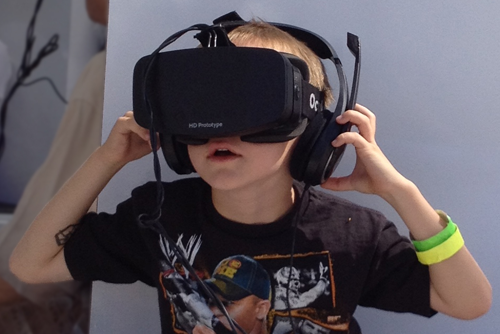 Reality has stiff competition these days. Wild fantasies are coming “true” right before our eyes via “virtual reality” or VR: the use of high-tech simulations that allow us to interact with environments and situations that seem incredibly authentic but aren’t really there.
Reality has stiff competition these days. Wild fantasies are coming “true” right before our eyes via “virtual reality” or VR: the use of high-tech simulations that allow us to interact with environments and situations that seem incredibly authentic but aren’t really there.
VR is claiming more territory in our perceptual landscape, thanks to simulated discussion groups (Usenet, Chat, ICQ), virtual role-playing settings (MUDS, MOOS), and games such as The Sims, Quake, and Everquest. Meanwhile, our mobile devices keep increasing their capability to run our lives.
For a quantum step forward in this evolution, prepare yourselves for Oculus Rift. Equipping users with a highly advanced headset, Oculus Rift offers an incredibly compelling VR experience. It provides a 110-degree field of view that keeps you in the game universe no matter where you look. Oculus Rift’s combination of engineering and highly advanced software virtually takes over your visual cortex, allowing you to look around corners, lean closer to something for a better view, and even lie down on a virtual beach.You may have trouble telling the difference between Rift and the real world.
Another leap into the VR future will be provided by the appropriately named Leap, a product from the company Leap Motion. This USB peripheral the size of an iPod provides a three-dimensional interaction area of eight cubic feet around your laptop or desktop computer. “It’s like being able to reach into the computer and pull out information as easily as reaching into a cookie jar,” Michael Buckwald, CEO and co-founder of Leap Motion, told PCWorld. “Leap senses individual hand and finger movements independently, as well as items like a pen. In fact, it’s 100 times more sensitive than existing touch-free products and technologies.”
Meanwhile, the ultra-innovative mind of game designer Will Wright, who gave us SimCity and The Sims, is adding to his impressive resume with the creation of HiveMind. Wright refers to HiveMind as “personal gaming,” a moniker that refers to its ability to customize itself to match you as an individual player by incorporating aspects of your real life into the game—everything from where you are to who your friends are to how much money you’re carrying. In a way, you don’t learn how to play HiveMind; it learns how to play you.
To me, there’s something equally alluring and off-putting about HiveMind. It reminds me of the movie Her, in which the character played by Joaquin Phoenix falls in love with a computer operating system (the voice of Scarlett Johansson) that seems to know more about him than he does. Then again, it would be pretty flattering to play in a world designed especially for me.
Although certainly not a complete list, here are 6 pros and 3 cons to virtual reality.
Pros
- Provides a safe way to build skills in challenging or risky tasks. Simulated practice modes are especially beneficial to surgeons in training, especially those performing laparoscopic surgery, who can view their technique on a video monitor. In fact, proficiency with video games tends to improve laparoscopic surgery performance. Noted Patricia Greenfield, Ph.D., a distinguished professor of psychology at UCLA, regarding one study: “The best video game players made 47 percent fewer errors and performed 39 percent faster in laparoscopic tasks than the worst video game players.”
- Offers real-time feedback. Getting instant results about success or failure can dramatically accelerate one’s learning curve. It also makes it easy to document and analyze outcomes.
- Allows skills to be developed at one’s own pace. Virtual learning environments can allow repeated practice of the same task and progression to the next level without delay when mastery is achieved.
- Expedites rehabilitation. VR systems that capture body movements via a camera can help people recover from injuries that impair mobility.
- Helps patients deal with severe pain. People suffering from severe burns are finding relief by playing SnowWorld, a virtual game that simulates a comforting environment and distracts patients from their pain by allowing them to shoot snowballs at penguins while listening to a song of their choosing. Another innovative simulation has proven effective for relieving phantom limb pain suffered by amputees. In a study reported in Frontiers for Neuroscience, a man suffering from such pain for 48 years experienced significant relief by viewing a virtual version of the limb that he could control via electrodes that measure movement at the base of the missing limb. More studies may make this type of therapy available on a wider scale.
- Helps people with autism. Children with autism interact well with technology, especially VR, which can help them learn social cues as well as enhance their motor skills. Justine Cassell, Ph.D., director of Northwestern University’s Center for Technology and Social Behavior, told NBC News that autistic children respond to VR because it is predictable, is easy to control, and has “infinite patience.”
Cons
- Hampers imagination and creativity. One could argue that VR enhances one’s imagination by providing all sorts of sensory stimulation. But imagination also involves abstract reasoning—thinking of things or ideas that aren’t in plain sight. In the virtual world, the “imagining” has already been done for you; it skews the balance in favor of input over output, which takes more of the self out of the equation. “Most visual media are real-time media that do not allow time for reflection, analysis, or imagination,” notes Dr. Greenfield. “Those do not get developed by real-time media such as television or video games. Technology is not a panacea in education because of the skills that are being lost.” The key takeaway: In learning, maintaining a balance between outside technology and the self is important.
- Blurs the boundaries between ourselves and the outside world. If we start spending a lot of our time in virtual worlds, where does that leave the real one? Technologies already exist that allow us to alter plots of movies, sequences of songs, even works of art. This can set us up to constantly compare our virtual experience with the real one—and perhaps blur our memory of which is which. Games like HiveMind that open up the sharing of our lives with countless others will also open the door to relentless commentary from others. Could this cause us to lose track of ourselves?
- Invades privacy. Our future may include the capability to place implants in our brains to enhance learning and the connection to virtual environments. But just as today’s computer systems have proved vulnerable to hackers, imagine if these implants were hacked as well. As Ramez Naam, a futurist and author of the science fiction novel Nexus told George Dvorksy in an article on the io9 website: “If we all have brain implants, you can imagine it driving a very bottom’s up world—another Renaissance, a world where people are free and creating and sharing more new ideas all the time. Or you can imagine it driving a world like that of 1984, where central authorities are the ones in control and they’re the ones using these direct brain technologies to monitor people, to keep people in line, or even to manipulate people into being who they are.”
For now, I give the edge to the pros. But the cons are troubling. They make me wonder whether VR could one day overstep its bounds and exert too much control over our lives.
Watch your back.
If you liked this article, you may be interested in reading:



